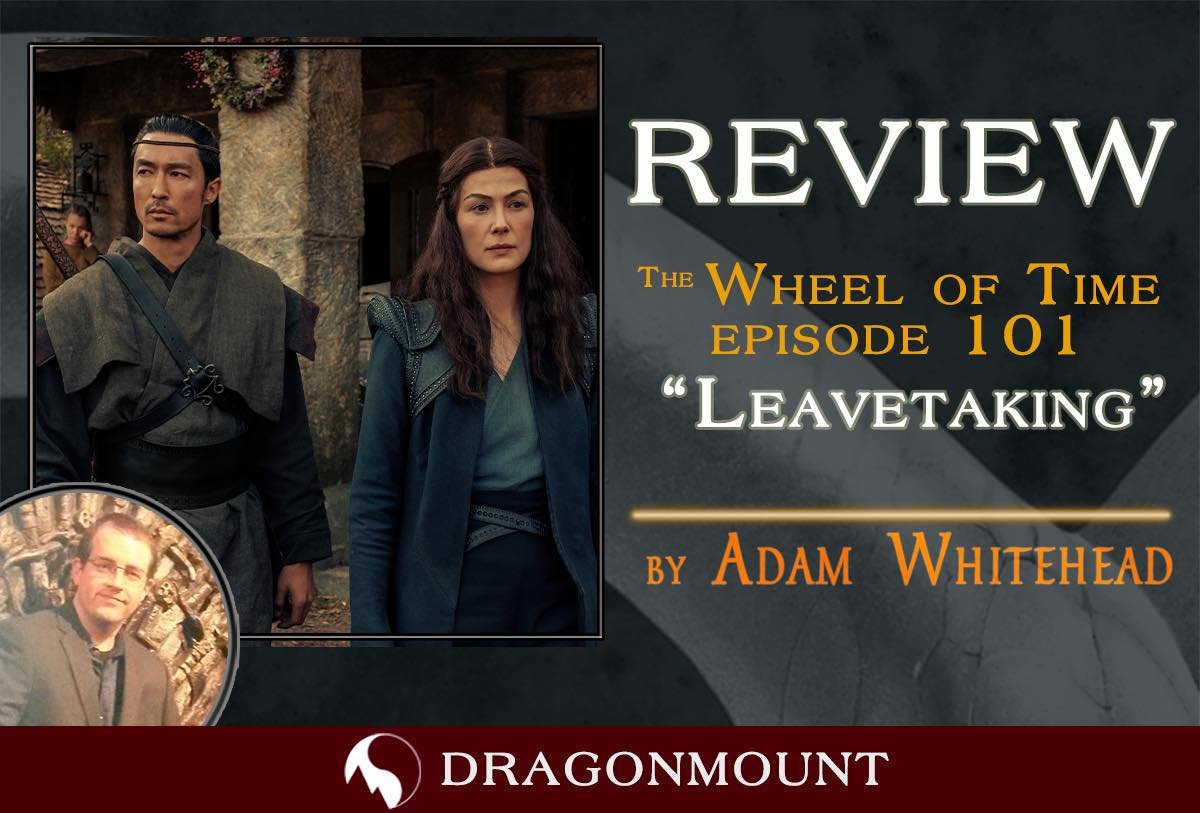
Adam Whitehead is Dragonmount's TV blogger. Adam has been writing about film and television, The Wheel of Time, and other genre fiction for over fifteen years, and was a finalist for the Hugo Award for Best Fan Writer in 2020. Be sure to check out his websites, The Wertzone and Atlas of Ice and Fire (including The Wheel of Time Atlas!) as well as his Patreon.
I started reading Robert Jordan’s Wheel of Time novels in 1996. A quarter of a century later, I sat down at the IMAX in Waterloo, London to watch the first episode of Amazon’s lavish TV adaptation of the series.
The weight of expectation is strong here. I saw The Fellowship of the Ring only five years after reading the book, and the first episode of Game of Thrones just over a decade after reading the first book in that series. But Wheel of Time has been part of my literary background for a lot longer. Can the adaptation - any adaptation - survive the weight of expectation that is thrust upon it?
The answer is “maybe,” and Rafe Judkins and his team have not aimed at a close or literal adaptation of the source material which attempts to replicate the novels line-by-line. Fortunately, it’s not an ultra-loose “inspired by the source material but also not really” kind of adaptation as we’ve seen recently with BBC America’s The Watch (where any similarities with Terry Pratchett’s Discworld novels are more by coincidence than design) or Apple TV+’s speculative take on Isaac Asimov’s Foundation novels.
The Wheel of Time instead charts an interesting middle ground, with some scenes directly lifted from the books - and certainly each major plot beat is lifted from the source material - and others invented to flesh out character background and motivation. In many cases these changes are improvements for the visual medium: rather than hear about the enigmatic matriarchal rituals of the Women’s Circle, we see one firsthand. Instead of hearing about Mat being a chancer and gambler, we see him playing dice. And instead of Rand and Egwene agonising over whether they want to be in a relationship or not, we see them debating about whether to continue a pre-existing relationship, which raises the stakes. The most controversial change is with Perrin: a young bachelor in the books, the show opens with him as a married man, albeit one whose relationship seems to be having its own issues. These changes help make the characters distinct rather than being similar young, single men, with their differences in character and temperament only emerging over time.
The most surprising thing about the first episode is how Judkins (who wrote this instalment) allows the episode to breathe. Over the course of an hour, he sets up the Aes Sedai, the curse of men who find they can channel the One Power, and the power dynamics and relationships within the village of Emond’s Field (which goes curiously unnamed, with all references being to the wider region of the Two Rivers). We explore Rand’s relationship with his father Tam, see Nynaeve’s sense of conflict at being both part of the community and, as Wisdom, outside of it, and that Mat has a problem with gambling. Another controversial choice is to make Mat’s parents troubled wastrels, with Mat showing signs of being a better man (doting on his sisters and ensuring their wellbeing) but also falling into the same temptations (as he likes a drink and a wager, but is not very good at mixing the two). I can see why these changes were made, to deepen and complicate the characters, but also the argument that these changes may veer on the cliche (and, in Perrin's case, indulging the tiresome fridging trope). Still, the measured introduction and dedication to the show’s worldbuilding and character relationships is a relief given fears that the show would have to blast through the major plot elements to get the story told in just eight short seasons. Whilst the slower start may compromise how much story can be told later on, it works very much in giving a good first impression of a show that cares about its characters, their relationships and making sure the audience can follow what’s going on. The show even strengthens book relationships, by giving Nynaeve much more of a reason to be angry at Moiraine, when the latter plays Columbo and manipulates Nynaeve into giving away invasive personal information just so she can work out her age.
The show’s visual design is sumptuous, with excellent set design and some breathtaking location shooting in the Czech Republic and Slovenia. Shots of Rand and Tam descending a mountain pass with their horse and cart, or Moiraine and Lan riding across the landscape, recall the epic vistas of The Fellowship of the Ring. The show replicates the book’s evocation of Tolkien without copying him outright, though a few moments come close: Padan Fain riding into town with a gaggle of children chasing his cart will have you waiting for the fireworks to fly out.
The Wheel of Time is a large and complicated story set in a large and complicated world, but the first novel, The Eye of the World, does a good job of easing readers into the setting. Judkins’ first episode does the same thing, with some elegant ways of getting worldbuilding info to the audience: rather than bald exposition about the dangers of men who can channel, the episode opens with a coterie of Red Sisters led by Liandrin hunting down two men who can channel...but in reality, it’s only one, the other a figment of his increasingly deranged imagination. A quiet Bel Tine scene has the villagers honouring the spirits of the departed, but knowing they will one day be reborn through the weavings of the Wheel, telling us this world is more a place of spiritual ideology and philosophy than religion as we know it.
The quiet worldbuilding of the early going is soon offset by an impending sense of dread. Moiraine and Lan’s arrival lets us and the villagers know that Trouble is Afoot, and even an unexpected bath scene which out-Witchers the infamous tub scene from The Witcher (featuring an, I’m assured, charismatic performance by Daniel Henney as Lan) cannot lessen the feeling of doom which builds excellently in the latter third of the episode. This culminates in the infamous Trolloc attack on the village on Winternight, with a dozen of the huge beasts (realised through a near-flawless mixture of prosthetics and CGI) running amok. In a nod to the varied origins of the creatures, we see wolf-headed Trollocs attacking upright but also dropping to all fours for greater speed or mobility (though that's where the CG can occasionally creak). At first the attack is a massacre, but the Two Rivers folk soon show their steel, with the Coplins and Congars putting their differences aside to bring down one of the creatures with pikes and staffs, whilst Perrin and his wife Laila fight off an interloping band into their forge with a mixture of hammers and axes. The best bit of fight choreography comes when Tam al’Thor shows his blademaster prowess by fighting off the presumed Narg in his farm. Book purists will weep to learn that Narg’s dialogue has been removed from the show, but this is probably for the best given how incongruous it is with later Trolloc behaviour.
The show finally lets loose by showing what it is capable of when Moiraine unleashes the One Power in the defence of the village. She uses Air to hurl Trollocs through the air with bone-snapping force, Fire to blast the enemy into ash and Earth to rip the ground apart around them. When the Trollocs are finally ready to overwhelm her, she uses a tornado to tear half the village apart and blast the Trollocs with a storm of masonry. It’s as impressive an action sequence as ever put on TV cameras, helped by most of the fighting and a lot of the reaction shots being done in-camera, with CGI being resolved only for specific moments that would be impossible to realise otherwise. Watching this scene in IMAX with a powerful sound system realising every explosion and scream was absurdly overwhelming. I have to confess to mixed feelings on the collateral damage: Moiraine literally tears the Winespring Inn apart to destroy the attacking Trolloc horde, and it’s unclear if she knew there was anyone inside. A scene from the second episode hints at a possible change to the Three Oaths: Moiraine indicates she can kill people inadvertently if she does not 100% know they are there or that will happen, as opposed to the books where it feels like Aes Sedai can’t channel destructive weaves indiscriminately if there’s even a chance an innocent might die in the crossfire. Whether this is a deliberate change or Moiraine was able to ascertain via some application of the Power that no innocents were in the firing line remains to be seen.
After that storm of battle, the episode ends with a coda: Moiraine telling Egwene, Rand, Mat and Perrin that the Dragon has been Reborn, and it’s one of the four of them. She has to take them out of the Two Rivers quickly to draw off the Shadowspawn pursuers before they return. This is an awkward scene because it conveniently gives the youngsters and Moiraine no time to check with their parents about the circumstances of their birth or arrival, otherwise the mystery of whom the Dragon Reborn is would die a quick death. However, it does give us that iconic final shot of the team leaving the Two Rivers with the Trolloc army on their heels, as Moiraine gives us the classic catechism and Lorne Balfe’s music stirs.
The first episode is a lot to take in, and purists will likely decry everything from Rand and Tam’s farm being moved (from the Westwood to a mountainous perch not far from town) to Two Rivers not being quite as cut off as in the books (there’s now an open road leading south to Ghealdan) and the insinuation that Egwene is both a ta’veren and a candidate to be the Dragon Reborn. Those more willing to accept changes for the visual medium will find much that is rewarding. The most surprising and welcome thing is that the episode doesn’t cut to the chase of explosions and battles ASAP, but spends a leisurely 40+ minutes building up characters, relationships and the world before bringing on the Shadowspawn. The vfx scenes have been hogging the attention in trailers, but it’s the quieter moments where the show sings: Tam and Rand grieving the loss of Kari, Egwene being accepted among the women of the town, Mat scrambling to afford a Bel Tine present for his sisters, and the villagers coming together to pay respects to the souls of the dead in a ceremony that seems to move even the stoic Moiraine. Lorne Balfe’s score particularly plays well in these quieter scenes and moments, though the music mix is perhaps a little too low in the released version (it was more noticeable in the IMAX).
Performances are uniformly excellent, with Rosamund Pike and Daniel Henney providing real gravitas and skill as Moiraine and Lan, and Michael McElhatton convincingly going from Worst Dad Ever in Game of Thrones to Best Dad Ever here. But the youngsters also prove their mettle: Barney Harris simply walks Mat out from the page and onto the screen, Madeleine Madden has impressive screen presence and Zoë Robins excels at portraying Nynaeve's sense of responsibility and care for the rest of the community, but also her loneliness. Marcus Rutherford and Josha Stradowski are lower-key presences at this point, but so are Perrin and Rand at this point in the novel (Mat somehow manages to steal scenes when he's not even the POV character), and what we see here is promising.
There are problems, and some of them feel a bit of a non sequitur at this point: the changes to Perrin don’t seem to add much to his character (especially given his limited ability to react to them in the two succeeding episodes); Padan Fain feels like a random addition to the series at this point; and the final scene where everyone has to leave abruptly without any time for exchanging seemingly vital plot and character information is somewhat contrived. The first preview scene from the episode, where Lan and Moiraine arrive in the village at night, is also awkwardly shot and paced. But beyond those scenes, Leavetakings does what it needs to do: it sets up the story in an interesting manner and leaves the viewer wanting to see more.
As usual, follow our casting and news pages, and let us know what you think of the latest developments.













Recommended Comments
Join the conversation
You can post now and register later. If you have an account, sign in now to post with your account.
Note: Your post will require moderator approval before it will be visible.